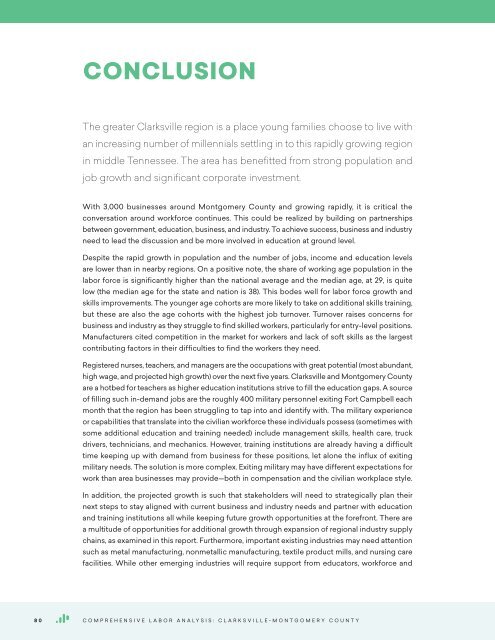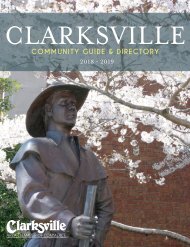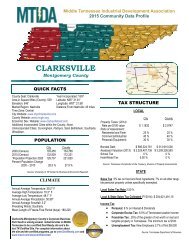Clarksville- Main File
You also want an ePaper? Increase the reach of your titles
YUMPU automatically turns print PDFs into web optimized ePapers that Google loves.
CONCLUSION<br />
The greater <strong>Clarksville</strong> region is a place young families choose to live with<br />
an increasing number of millennials settling in to this rapidly growing region<br />
in middle Tennessee. The area has benefitted from strong population and<br />
job growth and significant corporate investment.<br />
With 3,000 businesses around Montgomery County and growing rapidly, it is critical the<br />
conversation around workforce continues. This could be realized by building on partnerships<br />
between government, education, business, and industry. To achieve success, business and industry<br />
need to lead the discussion and be more involved in education at ground level.<br />
Despite the rapid growth in population and the number of jobs, income and education levels<br />
are lower than in nearby regions. On a positive note, the share of working age population in the<br />
labor force is significantly higher than the national average and the median age, at 29, is quite<br />
low (the median age for the state and nation is 38). This bodes well for labor force growth and<br />
skills improvements. The younger age cohorts are more likely to take on additional skills training,<br />
but these are also the age cohorts with the highest job turnover. Turnover raises concerns for<br />
business and industry as they struggle to find skilled workers, particularly for entry-level positions.<br />
Manufacturers cited competition in the market for workers and lack of soft skills as the largest<br />
contributing factors in their difficulties to find the workers they need.<br />
Registered nurses, teachers, and managers are the occupations with great potential (most abundant,<br />
high wage, and projected high growth) over the next five years. <strong>Clarksville</strong> and Montgomery County<br />
are a hotbed for teachers as higher education institutions strive to fill the education gaps. A source<br />
of filling such in-demand jobs are the roughly 400 military personnel exiting Fort Campbell each<br />
month that the region has been struggling to tap into and identify with. The military experience<br />
or capabilities that translate into the civilian workforce these individuals possess (sometimes with<br />
some additional education and training needed) include management skills, health care, truck<br />
drivers, technicians, and mechanics. However, training institutions are already having a difficult<br />
time keeping up with demand from business for these positions, let alone the influx of exiting<br />
military needs. The solution is more complex. Exiting military may have different expectations for<br />
work than area businesses may provide—both in compensation and the civilian workplace style.<br />
In addition, the projected growth is such that stakeholders will need to strategically plan their<br />
next steps to stay aligned with current business and industry needs and partner with education<br />
and training institutions all while keeping future growth opportunities at the forefront. There are<br />
a multitude of opportunities for additional growth through expansion of regional industry supply<br />
chains, as examined in this report. Furthermore, important existing industries may need attention<br />
such as metal manufacturing, nonmetallic manufacturing, textile product mills, and nursing care<br />
facilities. While other emerging industries will require support from educators, workforce and<br />
80<br />
COMPREHENSIVE LABOR ANALYSIS: CLARKSVILLE-MONTGOMERY COUNTY












